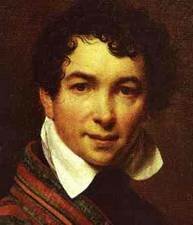 Orest Adamovich Kiprenskij13.03.1782 Myza Nezhinskaja, near Koporje, Leningrad region - 17.10.1836 Rome Canvases of Orest Adamovich Kiprenskij [53 canvases]Short information:Orest Kiprensky was one of Russia's leading painters of the first half of the XIX century, who also achieved international recognition. His self-portrait was placed in the Uffizi Gallery in Florence along with the portraits of the worlds' greatest masters. Biography of Orest Adamovich KiprenskijIt is believed that Orest Kiprensky was an illegitimate son of the landowner Alexey Dyakonov and one of his serfs. Orest was born on the 24th of March, 1782, in the village Koporye, near St. Petersburg on a grange, owned by his father. He was raised in the family of Adam Shvalber, a serf. Although Kiprensky was born a serf, he was released from the bondage upon his birth and his father helped him to be admitted to the Academy of Arts in St. Petersburg in 1788. In the Academy of Arts Orest was trained to become a historical painter, which was considered to be the highest achievement for an artist. After graduating from the Academy in 1803, he was left there as a pensioner for three more years to help him to fulfill the necessary requirements to win the Major Gold medal. Winning the first prize enabled the young artist to go abroad to study art in Europe. Orest was to create a big historical picture to achieved the goal. Prince Dimity Donskoy after the Kulikov Battle (1805) became the picture, for which the Academy awarded him the Major Gold medal. A year before, in 1804, at the Academy's exhibition he showed the Portrait of A. K. Shvalber (1804), which was a great success. The portrait so impressed his contemporaries, that later a group of experts, members of the Naples Academy of Arts, expressed an opinion that the picture was a production of one of the great masters of the past - Rubens, Rembrandt or Van Dyke. Kiprensky had to ask for letters from the members of the St.Petersburg Academy of Arts supporting his authorship. During the following years Kiprensky created a lot of portraits, among the best are Portrait of the Princess A. V. Scherbatova and the Prince P. P. Scherbatov (c.1808), Portrait of A. A. Chelischev (c. 1809), Portrait of Count V. A. Perovsky (1809), Portrait of Countess Ye. P. Rostopchina (1809), Portrait of Denis Davydov (1809). During Napoleon's invasion of 1812, he created several graphic portraits of people who fought with the French. Portrait of Peter Olenin (1792-1868) was finished just before 18-year-old Peter with his 19-year-old brother Nicholas went to fight the Battle of Borodino, where Nicholas was killed and Peter severely wounded. In the post-war period Kiprensky created masterpieces of portraiture such as Portraits of D. K. Khvostova and V. S. Khvostov (1814), Portrait of A. I. Molchanova with Daughter (1814), Portrait of Count S. S. Uvarov (1815-1816), Portrait of the Poet V. A. Zhukovsky (1815) and others. Only in 1816, Orest Kiprensky managed go to Europe to study the art of old masters. He spent seven years in Italy and created historical pictures there: Tomb of Anacreon (1821), several genre pictures Young Gardener (1817), Girl Wearing the Poppy Wreath, also known as Portrait of Mariucci (1819) , Gypsy Girl with a Twig of Myrtle (1819) and others. And of course he kept painting portraits in various techniques, among the best are Portrait of the Princess S. S. Scherbatova (1819), Portrait of the Prince A. M. Golitzin (c.1819), Portrait of E. C. Avdulina (1821 - 1823). In Italy he met a little girl Anne Maria Falcucci (Mariucci), to whom he became attached. He bought her from her dissolute mother and made her his ward. On leaving Italy, he gave her to a Catholic convent. After his return from Italy Kiprensky continued to paint portraits, his favorite genre. The most notable were Portrait of Count D. N. Sheremetyev (1824), Portrait of O. A. Ryumina (1826), Portrait of the Prince N. P. Trubetzkoy (1826), Portrait of A. F. Shishmarev (1827), Self-portrait (1828), Sibyl of Delphi (Portrait of N. S. Semenova.) (1828), Portrait of A. A. Olenina (1828), Portrait of Alexander Pushkin (1827). In 1828, Kiprensky came back to Italy. The reason for his second trip was the letter from his friend in Italy S. Galberg, which informed him that he lost track of Mariucci. Kiprensky found Mariucci, she had been transferred to another convent. In Italy he went on working. He created The Sibyl of Tibur (1830), a big canvas in the historical genre, but the painting was not successful. There were several remarkable genre pictures: Naples Boys (1829), Naples Girl with a Bowl of Fruits (1831), Readers of the Newspaper in Naples (1831) and portraits: Portrait of F. A. Golitzin (1833) and Portrait of the Sculptor Bertel Thorvaldsen (1833). In July 1836, Kiprensky was able at last to take Mariucci from the convent and marry her. He died from pneumonia three months later on the 5th of October 1836 and was buried in Rome. His daughter Constance was born after his death.
You can find canvases of this artist in these museums: |
Quick Search artists |
|||||||||||||||